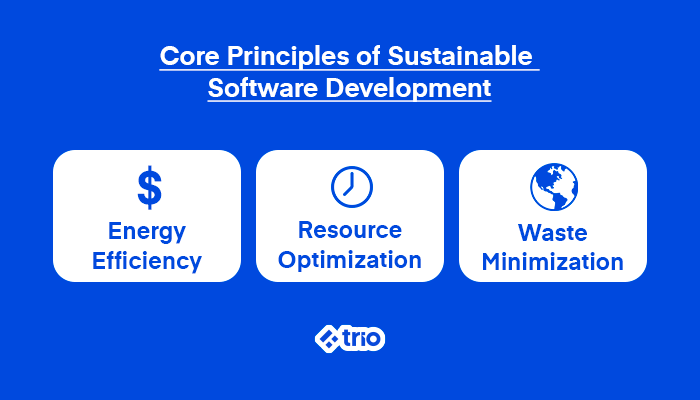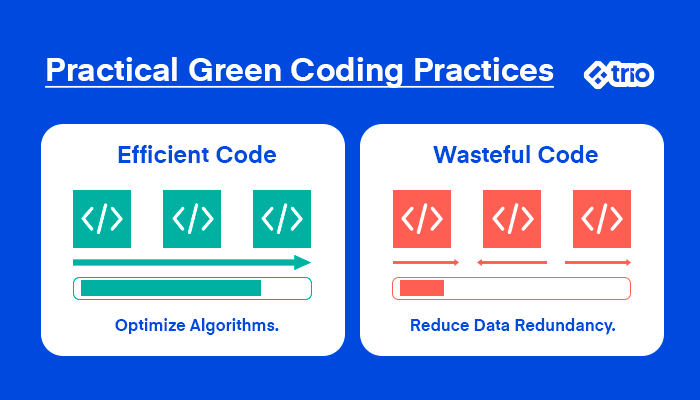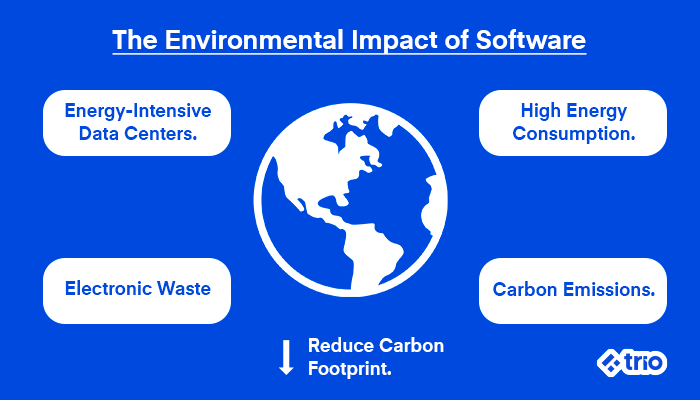In a world where sustainability is no longer just an option but a necessity, you may need to consider reassessing your software design strategy.
The tech industry, known for its rapid innovation, is now at the forefront of this movement. As a leader in a well-established tech company, you may already be familiar with the pressing need to reduce your carbon footprint.
But how can software development contribute to a more sustainable future?
Let’s look at green software engineering – or green computing – including the fundamental principles, benefits, and best practices of sustainable software development.
We’ll also cover practical insights on making your software solutions more eco-friendly.
Here at Trio, we would like to support you in implementing these practices and ensure that your software development meets and exceeds sustainability goals.
What Are the Key Principles of Sustainable Software Development?

Understanding the Principles of Sustainable Software
Sustainability in software development is grounded in core software engineering principles prioritizing long-term environmental impact over short-term gains.
These principles include reducing energy consumption through energy-efficient software, optimizing resource usage, and minimizing waste throughout the software development life cycle.
By adhering to these green software engineering principles, your developers can develop sustainable software applications that are not only efficient but also environmentally responsible.
At Trio, we understand that implementing these green IT practices requires a deep commitment to sustainable software development practices and strategies.
Our team of experts can help you integrate these core values into your development process, ensuring that your software products are practical and sustainable.
How to Implement Sustainable Software Development Practices
Are you ready to start your development project?
We have the developers you need to take your development project in the right direction.
Companies are proven to grow their business faster with Trio.
Implementing sustainable software development practices begins with thoroughly understanding your current processes and approach to software development.
This includes evaluating your existing codebase, development tools, and deployment strategies to identify areas where energy and resources can be conserved. All of these are fundamental principles of green programming.
By adopting greener software practices, such as more efficient algorithms, optimizing data storage, and reducing unnecessary processing, you can significantly reduce the carbon footprint of software systems you create.
We can assist with our tailored solutions that can help you transition to more sustainable practices, from optimizing your code to selecting eco-friendly development tools that align with your sustainable development goals.
Core Practices of Sustainable Software Development
Optimizing code for energy efficiency is essential because it minimizes the energy required to execute operations.
Efficient code reduces processing time and lowers the overall power consumption of data centers, which directly contributes to lowering the carbon footprint of software applications.
Reducing data redundancy is another crucial practice. By minimizing duplicated data, you decrease the amount of storage required, which in turn reduces the energy needed to maintain and manage that data.
This not only conserves energy but also extends the lifespan of storage hardware, further contributing to sustainability.
Employing virtualization helps by consolidating multiple applications onto fewer servers, reducing the need for additional physical hardware.
This practice cuts down on energy consumption and reduces the cooling requirements of data centers, leading to significant energy savings.
This approach not only meets sustainability goals but also enhances the overall efficiency and performance of your software solutions.
Additionally, embracing sustainable software development practices by adopting continuous integration and continuous deployment (CI/CD) pipelines can streamline development processes, reducing waste and improving efficiency.
With Trio’s extensive experience in sustainable development, we can guide you through the adoption of these practices and the ever-changing industry standards, ensuring that your software development process is both green and efficient.

What Are the Benefits of Sustainable Software Development?
Reducing the Carbon Footprint Through Software Engineering
One of the most significant benefits of sustainable software development is its potential to reduce your organization’s carbon footprint.
By optimizing energy use and reducing the need for extensive hardware resources, green software engineering can significantly decrease the carbon emissions associated with software production and operation.
Trio can help you assess your current carbon footprint and develop strategies to reduce it through eco-friendly practices, ensuring that your software not only meets user needs but also contributes to a healthier planet.
Enhancing Energy Efficiency in Software Applications
Energy efficiency is a critical aspect of sustainable software development and green initiatives.
By focusing on optimizing code and reducing the energy consumption of sustainable applications, your developers can create solutions that require less power, both during development and in operation.
Our team at Trio specializes in enhancing energy efficiency in software, helping you build applications that are not only powerful but also environmentally conscious.
Long-Term Sustainability Goals for Developers
Setting long-term sustainability goals is essential for any organization committed to green software engineering.
These goals might include reducing overall energy consumption by a certain percentage, achieving carbon neutrality in your software operations, or adopting renewable energy sources for data centers.
Trio can assist you in setting realistic and impactful sustainability goals, providing the tools and expertise needed to achieve them.
How to Implement Green Coding Practices?
Steps to Optimize Energy Consumption in Software Development
Optimizing energy consumption in software development involves several key steps, including the use of energy-efficient programming languages, optimizing algorithms for performance, and reducing unnecessary computations.
Additionally, developers should consider the energy impact of different hardware configurations and choose the most efficient options available.
We can offer you comprehensive guidance on optimizing energy consumption, helping you implement green coding practices that align with your sustainability objectives.
Programming Languages that Support Green Software Engineering
Some programming languages are inherently more energy-efficient than others.
For example, languages like Rust and Go are known for their efficiency and low energy consumption compared to more resource-intensive languages like Java and Python.
Choosing the correct programming language can significantly impact the energy efficiency of your software.
You need to consider what your developers are familiar with as well. If they need to learn a new language and can’t code efficiently, they will develop software that requires more energy.
Our team at Trio can help you select the most suitable programming languages for your green software engineering projects, ensuring that your code is both efficient and sustainable.
We also have a host of vetted developers who are knowledgeable about sustainable software development best practices.
Practical Tips for Implementing Green Coding
Beyond just picking the right programming language, companies can take several practical steps to ensure their software is as eco-friendly as possible.
Many cloud providers, such as AWS, Google Cloud, and Microsoft Azure, offer tools that help monitor and manage carbon emissions.
For instance, Microsoft’s Cloud Sustainability Calculator allows companies to track the environmental impact of their cloud usage and optimize configurations to reduce their carbon footprint.
Another important strategy is to embrace open-source software.
By contributing to and utilizing open-source projects, companies can reduce the redundancy of development efforts and promote the efficient use of resources.
Open-source communities are often at the forefront of sustainable practices, sharing code that is already optimized for performance and energy efficiency.
You should also consider implementing automated energy monitoring tools into your development pipeline, which can provide real-time feedback on the energy efficiency of your code.
This allows your developers to make immediate adjustments that not only improve sustainability but also enhance the overall performance of the software.
Designing for a sustainable user experience (UX) is also crucial.
Efficient UX design minimizes the number of interactions needed to achieve a task, reducing the load on servers and the energy consumed by your software.
This might involve simplifying navigation, reducing the number of server requests, or optimizing data transfer protocols.
Lastly, consider using serverless architectures where feasible.
Serverless computing dynamically allocates resources based on demand, ensuring that you’re only using the energy you need, particularly during low-usage periods. This not only reduces energy consumption but also lowers operational costs.
At Trio, we integrate these practices into our approach to software development, ensuring that every project not only meets high standards of performance but also aligns with sustainable development goals.
By focusing on these practical steps, we help our clients create software that is both efficient and environmentally responsible.
How Does Sustainable Software Development Impact the Environment?

The Environmental Impact of Software Applications
While software might seem intangible, its environmental footprint is very real. The energy needed to develop, maintain, and run software applications contributes to a range of environmental issues, from carbon emissions to resource depletion.
Every line of code, every data transfer, and every server request consumes energy, which, depending on the source, often results in carbon emissions.
As alluded to above, the infrastructure required to support software – data centers, servers, and cooling systems – uses significant amounts of power, leading to further environmental strain.
Beyond energy use, software also contributes to electronic waste.
As software evolves, the hardware required to run it efficiently often becomes obsolete, leading to the disposal of older devices.
This cycle of hardware updates and disposal creates a continuous stream of e-waste, which is difficult to recycle and often ends up in landfills, contributing to pollution and toxic waste issues.
The environmental impact of software applications is thus far-reaching, affecting everything from the carbon footprint of energy-intensive data centers to the growing problem of electronic waste.
Reducing Carbon Emissions in the Software Development Lifecycle
The software development lifecycle (SDLC) encompasses all stages of software creation, from planning and development to deployment and maintenance.
Each stage has its own environmental footprint, primarily through energy use and resource consumption. By optimizing each stage for sustainability, organizations can reduce their overall carbon emissions.
With Trio’s expertise in sustainable development, we can help you reduce carbon emissions throughout your SDLC, ensuring that every phase of your software development is as green as possible.
Strategies for Environmental Sustainability in Software Solutions
Achieving environmental sustainability in software solutions requires a multifaceted approach.
This includes adopting renewable energy sources for powering data centers, using energy-efficient hardware, and optimizing software for performance.
You should also consider the end-of-life technology management of software, ensuring that outdated systems are properly recycled or repurposed.
Trio can guide you through the development of these strategies, helping you create software solutions that are not only effective but also environmentally sustainable.
What Are the Best Practices for Sustainable Software Engineering?
Adopting Sustainable Development Practices
Adopting sustainable development practices involves a commitment to continuous improvement and innovation.
This includes regularly reviewing and updating coding practices, staying informed about the latest advancements in green technology, and fostering a culture of sustainability within your development team.
Trio can help you adopt and implement these practices, ensuring that your software engineering processes remain at the cutting edge of sustainability.
Integrating Sustainability Throughout the Software Development Process
Sustainability should be integrated into every stage of the software development process, from initial planning to final deployment.
This involves setting sustainability goals at the outset, choosing energy-efficient tools and languages, and continuously monitoring and optimizing your software for energy efficiency.
If you are already working on a project, integrating these practices might be difficult. That is one of the reasons why we recommend developers who are able to code for continuous integration.
With Trio’s support, you can integrate sustainability throughout your development process, ensuring that every line of code contributes to a greener future.
Exploring the Role of Software Developers in Sustainability
Software developers play a crucial role in sustainability.
By adopting green coding practices, staying informed about the environmental impact of their work, and advocating for sustainable practices within their organizations, developers can make a significant contribution to global sustainability efforts.
Trio is here to support developers in this role, providing the resources and expertise needed to drive sustainability in software engineering.
Sustainable software development is not just a trend; it’s a necessary evolution in the tech industry.
By adopting green software engineering practices, your organization can reduce its environmental impact, enhance energy efficiency, and contribute to long-term sustainability goals.
Trio is your partner in this journey, offering the expertise and support needed to implement these practices effectively. Together, we can build a more sustainable future, one line of code at a time.







